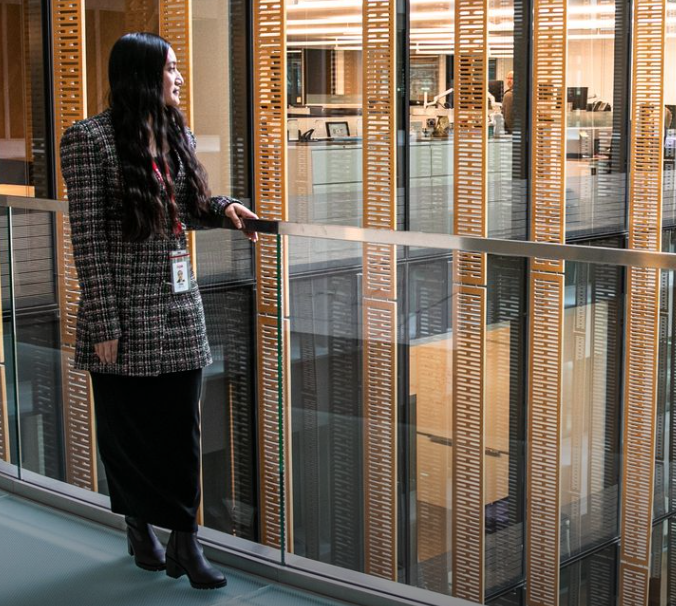
Last spring Dina Sosa Cruz sat with her parents and sister in the family’s living room and reviewed her options: a full academic ride to the University of the District of Columbia, or an apprenticeship in the insurance industry.
The college route meant at the end of four years the 22-year-old would have a degree, a little debt and no work experience. The apprenticeship would leave her with a two-year degree, money in the bank and training in a profession that appealed to her.
Her family was unanimous: Take the apprenticeship. “You’ll be worry free,” her mother said.
Family conversations like the one in Ms. Cruz’s living room are bubbling up around the country as high-school seniors recalibrate their options after the pandemic prompted a historic disengagement from school. The result has been the acceleration of a shift away from the nation’s half-century “college-for-all” model toward a choice of either college or vocational programs—including apprenticeships.
Today, colleges and universities enroll about 15 million undergraduate students, while companies employ about 800,000 apprentices. In the past decade, college enrollment has declined by about 15%, while the number of apprentices has increased by more than 50%, according to federal data and Robert Lerman, a labor economist at the Urban Institute and co-founder of Apprenticeships for America.
Apprenticeship programs are increasing in both number and variety. About 40% are now outside of construction trades, where most have traditionally been, Dr. Lerman said. Programs are expanding into white-collar industries such as banking, cybersecurity and consulting at companies including McDonald’s Corp. , Accenture PLC and JPMorgan Chase & Co.
Apprenticeships take many forms but generally pair students with a course of study focused on a particular occupation and practical work experience under the supervision of a mentor. Typically, employers pay costs associated with school as well as a wage.
Some programs have boomed in popularity, with admission rates as competitive as those at some Ivy League universities.
The gap between the number of students going to college and those selecting apprenticeships is closing as many employers are struggling to find workers in the tightest job market in half a century. Meanwhile, more students say they are wary of enrolling in college for fear it will leave them in debt and holding a degree that hasn’t prepared them for a good job in a fast-changing labor market.
As a result, some employers say a mismatch has developed between the skills employers are seeking and the lessons students are learning in college and university courses. To address the mismatch, companies are dropping requirements for degrees for some jobs, and states are rebuilding the vocational-education pathways that were de-emphasized two generations ago when the nation adopted a college-preparatory path for nearly all students.
Companies such as Alphabet Inc.’s Google, Delta Air Lines Inc. and International Business Machines Corp. have responded by dropping college degrees as requirements for some positions and shifting hiring to focus more on skills and experience. Pennsylvania has cut college-degree requirements for some state jobs, and Maryland has set a statewide goal of 45% of high-school students starting a registered apprenticeship by 2031.
About one-third of Maryland high-school graduates have earned a community-college degree or four-year-college degree by the age of 25, said State Sen. James Rosapepe, who has championed the apprenticeship programs. He called that proof that the college-for-all model is falling short.
Mr. Rosapepe characterized the national skills mismatch as an information problem. Colleges and the military actively recruit in high schools to educate students about their options. Little information, he said, is shared about all the other trades or professions.
“We’ve paved the path for the one-third, and we let the other two-thirds wander aimlessly in the woods,” said Mr. Rosapepe. “It’s not fair to them and it’s obviously economically inefficient.”
Zurich North America, an insurance firm, says it hired 92 apprentices last year, many right out of high school, from more than 800 applicants. Most apprentices attend community college. They are based in offices across the country where they work stints in different departments such as underwriting, claims, audit, statistical reporting, IT, cybersecurity and reinsurance, said Al Crook, who leads the company’s apprenticeship program.
EJ Crespo, 20, is now in the billing audit department at Zurich’s office in Schaumburg, Ill., outside of Chicago. He said there is an adjustment to working in an office with people his parents’ age, but said he has become proficient at data analysis and Excel since he began.
He earns about $40,000 a year while taking four classes a semester at a community college and working 24 hours a week during the school year—and full time in summer.
“I literally didn’t know anything when I got here, and they taught me all these skills,” he said.
The Aon PLC apprenticeship program in which Ms. Cruz enrolled began in 2016 and that year accepted 40% of applicants. Last year, the program drew 1,100 applicants for 90 spots. This year, the applicant pool grew to 1,500 for 100 positions. That 7% acceptance rate makes the program as selective as Cornell University and Dartmouth College.
“A lot of the growth is word-of-mouth,” said Bridget Gainer, spokeswoman for Aon, a global professional-services firm based in Chicago.
The longest-tenured apprentices are four years past graduation and are earning 15% to 25% more than when they started, she said. They have also been easier to retain.
Research from other countries shows that success may be short-lived. Eric A. Hanushek, a Stanford University economist, said that the skills learned in an apprenticeship might not be of much help down the line.
“People get more specific skills in apprenticeship programs than they do in college and while that helps them enter the labor market with greater ease at the beginning of their careers, later in life their skills depreciate,” he said. “So at age 45 or 50 or 55, these people are less likely to stay in the labor market because their skills are less valuable.”
By contrast, a college degree offers a broader, general education, which “makes people more adaptable and able to learn new skills that show up later when the economy changes,” he said.
Employers might be getting the better end of the bargain because they are able to hire apprentices at relatively low wages, he said.
The admissions process for apprenticeships generally includes three or four steps over several months. Applicants are typically given tests to measure a host of attributes, such as attention to detail, writing and math skills, and an ability to work in teams.
In Indiana, the college-enrollment rate among male high-school graduates fell to 53% in 2020 from 65% in 2015, according to the Indiana Commission for Higher Education. A consortium of businesses in central Indiana helped launch a program to get high-school students enrolled in two- or three-year apprenticeships at the start of their junior year.
“There are a lot of kids in college who you can tell just aren’t invested in being there,” said Addison McKown, spokeswoman for Modern Apprenticeship in Indiana and a recent graduate of Butler University. “This gives them another option.”

